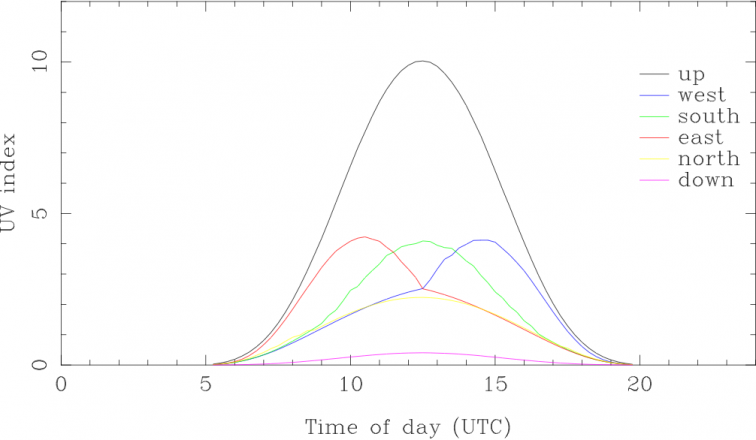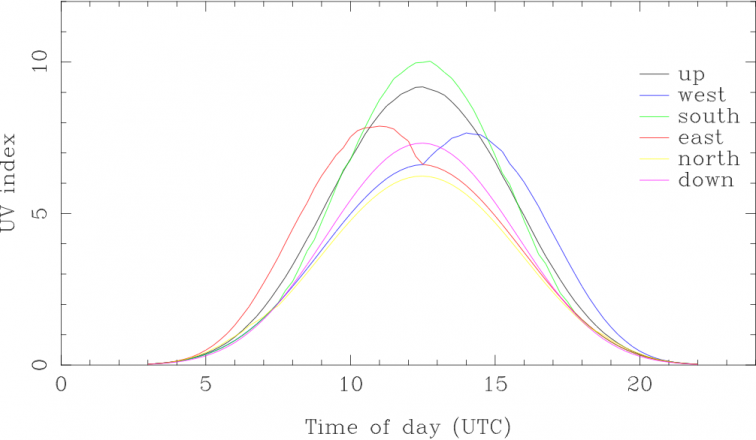UV-radiation on tilted surfacesUV-radiation, whether measured or predicted, is typically presented for a horizontal surface. An example is the UV-index routinely reported to the general public. However, the exposed surface on which the UV-radiation acts, is seldom oriented similarly to the way the surface used to report and predict UV-levels. The libRadtran software tools may be used to calculate the radiation for a surface of any orientation and atmospheric and surface conditions. As an example the UV-index will be calculated for various locations and surface orientations. To do so erythemal weighted radiances fields are first calculated with uvspec. A sample input file is solar_file libRadtran/data/solar_flux/apm_1nm
albedo 0.04
aerosol_default
sza 86.8863
phi0 353.452
nstr 16
data_files_path libRadtran/data/
altitude 0.0
filter_function_file ./CIE.dat
day_of_year 166
output integrate
wvn 280.00 400.00
rte_solver sdisort
atmosphere_file libRadtran/data/atmmod/afglms.dat
ozone_column 300.0
umu -0.999990 -0.999848 -0.999391 -0.998630 ..... equidistant from -90 to 90 in steps of 1 degree.
...... 0.994522 0.996195 0.997564 0.998630 0.999391 0.999848 0.999990
phi 0.0 5.0 10.0 15.0 20.0 .... equidistant from 0 to 360 in steps of 5 degree.
....... 345.0 350.0 355.0 360.0
In order to be able to accurately integrate the radiances to get an irradiance-like quantity on an arbitrarily oriented surface a rather high resolution of umu and phi is needed. The input file covers zenith angles between -90 and 90 degrees with a resolution of 1 degree. In the azimuth direction the interval 0 to 360 degrees is covered with a resolution of 5 degrees. The resulting spectral radiances were weighted with the erythemal action spectrum and integrated over wavelength. To calculate the UV index the radiances must be integrated over angle to yield the irradiance. This is done internally in the various rte solver in uvspec for horizontal surfaces. For surfaces with an inclination this must be done in a seperate calculation. The libRadtran package contains the angres tool that may be used for this purpose. Input to angres is provided by two files: the radiance field and the angular response. The latter is here a cosine function to yield the irradiance. Furthermore, the tilt angle and rotation around azimuth for the surface, and zenith and azimuth angles of the sun, are required input. The angres tool reads the input files, tilts and rotates the surface and integrate the radiance field over zenith and azimuth angle using a Monte Carlo technique. A sample run for a surface tilted 90 degrees is angres ANGRES_1_ANG.DAT UVSPEC.OUT -z 353.452 -s 86.8863 -a -t 90 -r 0 The angular response file is readily made by the make_angresfunc in the libRadtran package. make_angresfunc -t 1 -r 1 > ANGRES_1_ANG.DAT Radiances were calculated for the locations of Mallorca, Spain, 39.0N; Jostedalsbreen, Norway, 61.7N; and Tromsø, Norway, 69.65N, for the 15th of June. For Mallorca and Tromsø the calculation were performed at sea level. However, for Jostedalsbreen, the largest glacier in Norway, the calculations were made at 1900 meters above sea level. Calculations were performed for the whole day with a time resolution of 5 minutes. It is noted that the UV index is defined for a horizontal surface. Below the UV index is also used to quantify the amount of radiation incident on inclined surfaces. This is done to ease comparison. The situation in the below figure represents a typical standard situation for a cloudless midlatitude location. The UV index is shown for 15 June at sea level on Mallorca. The red curve represents downwelling irradiance on a flat horizontal surface, wile the yellow curve is the upwelling irradiance. The magenta, blue, green and purple colored lines represent the irradiance incident on a vertical surface facing east, south, west and north respectively. The vertical oriented surfaces facing west and east recceives slightly more radiation than the surface facing due south. The north facing vertical surface recieves only scattered radiation amounting to a maximum UV index of about 2. The horizontal surface facing down recieves the least amount of radiation due to the low surface albedo. Thus, besides atmospheric and surface optical properties, it is obvious that exposure to the direct sun and the orientation in azimuth and zenith of the exposed surface, are important factors with regard to the received UV dose. The below figure is similar to the one above, except the location is Jostedalsbreen. The altitude is 1900 meters and the surface albedo is 0.8. There are a few things to comment about these two figures: First, for this time of the year, the days are longer the further north one goes. Hence, the radiation is present for a longer time on Jostedalsbreen than on Mallorca. Secondly, the impact of a highly reflecting snow surface, here accounted for by using an albedo of 0.8, implies that the vertical south facing surface receives more UV radiation than the horizontal up facing surface. Furthermore, the down facing horizontal surface receives more radiation than the vertical north facing surface. Finally, except for the up facing horizontal surface, all other surfaces on Jostedalsbreen receives significantly more radiation, maximum between 6 and 10 UV indices, compared with the same quantities for Mallorca, maximum between 1 and 4 UV indices. This is mostly an albedo effect. |

